#speculative pokemon biology
Text
Kabuto have a long and extensive fossil record, dating its development and evolution throughout prehistory. One of the most amazing variations among Kabuto is the eyes, which have a great many variations and changes.
The earliest Kabuto fossils revealed crescent-shaped lenses. These lenses allowed it a spectacular range, allowing it to scan its surroundings at nearly 360 degrees around it. These lenses lasted about 50 million years.
The variations afterward are of an astounding volume. Some Kabuto were found with eyestalks! These fossils were not complete enough to be revived reliably, but a handful of revived eyestalk Kabuto are owned by researchers. Eyestalks give it a better field of view, extending its sight outside of its shell. This gives Kabuto a better view above it. Eyestalks also meant Kabuto could bury themselves under the sand and still have full view of the ocean around it.
The standard Kabuto revived from fossils are all but standard. These Kabuto have some of the most advanced optics of any Pokemon, living or extinct! Many, many lenses are stacked on each other, ranging from 10 to an impressive 50. This gives Kabuto a particularly vivid view, one that humans can not even properly percieve! Kabuto with stacked lenses see the world in excessive detail and in a vibrant array of colors.
The later fossils show two distinct types of eyes. These reflect the environment Kabuto live in, either the deepest depths of the ocean or on the shallow shores.
For the Kabuto in shallow waters, their eyes developed a stack of over 200 individual lenses. That is an insane amount of detail for such a little guy!
In the complete opposite spectrum, Kabuto living in the deep sea lost nearly all of their lenses. They were practically blind! Their eyes also got much smaller as a result, as they had little need for strong vision.

(OOC: Most information here was adapted from this article on trilobite eyes. Its a fascinating read if you have the time, and it has pictures!)
28 notes
·
View notes
Note
Hello! Trainer from Alola here, big fan of your work. I was wondering; is there any evidence of any legendary pokemon being related to other pokemon? For example, does Rayquaza share any DNA with other dragon pokemon? (I know it would be extremely difficult to get any rayquaza DNA fhshfjd) Or are pokemon like that entirely their own species?
the answer is, as with many things on this blog.. it depends!
"legendary pokemon" aren't really a cohesive category like, say, a type or a taxonomic group. the only common factors are that they tend to be very rare and that they have legends about them. as our examples, let's use two groups of hoenn legendary pokemon: latios and latias, and groudon, kyogre, and rayquaza.
latios and latias (like other pairs such as nidoqueen and nidoking, or volbeat and illumise, latios and latias are sexually dimorphic members of the same species) are indeed related to other pokemon- they're birds! specifically, they're in the auk family, which are a group of generally stout, seafaring birds like guillemots and puffins. this may seem strange- the latis appear to have wings and arms, and no legs, very unlike birds. however, if we take a look at their skeleton, the connection becomes much more obvious:

what we generally interpret as arms are actually the lati's legs, the thighs of which are obscured by flesh and feathers. while they use their wings to steer and for some lift, the latis generally stay aloft with their psychic powers rather than traditional flight, which is why they can hover in place. this has freed up their legs for use in manipulating objects, and they are rarely seen standing on their feet. because they mostly rely on hovering, their legs no longer have the strength to hold their large bodies up for very long.
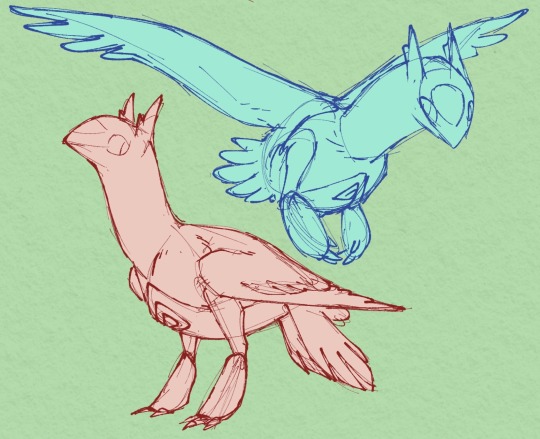
these pokemon are indeed exceptionally rare, having very low population numbers in only a few regions, and spending most of their time over open ocean. like many pelagic seabirds, they breed on only a few small islands, like alto mare off the johto region and southern island off hoenn's south coast. their populations are on the upswing, though, in large part due to concentrated conservation efforts on those islands. point being, though, they are indeed just animals. rare, powerful animals, but animals nonetheless.
many legendary pokemon fall into this camp. articuno, zapdos, and moltres, lugia and ho-oh, heatran, and various others.
.
conversely, the so-called weather trio of hoenn: groudon, kyogre, and rayquaza. these three are even more rarely seen than the latis, only having been sighted in recent times during their clash in hoenn nearly two decades ago. despite the three's resemblance to other living pokemon, as far as we know they are entirely unrelated to any known animals, or even any other life on earth.
this is known because evidence of these pokemon have been found dating back over 3 billion years ago, that is to say over a billion years before multicellular life even existed. gigantic fragments of footprints attributed to groudon have been sighted alongside some of the earliest fossils we know of of early bacteria. modern physical samples from these pokemon- the extremely few that have ever been recovered- have never resulted in any dna evidence, and appear in structure much more similar to inorganic matter.
as it stands, it appears these pokemon arose some time early (relatively speaking) after the earth formed, being (as opposed to natural living organisms) animate representations of the forces of nature themselves. a similar condition is often assumed for some other grandiose legendary pokemon, such as dialga and palkia, though much less tangible evidence exists for their presence in prehistoric time, so this is mostly an assumption based on their infrequent appearances & legends surrounding their origins.
428 notes
·
View notes
Text
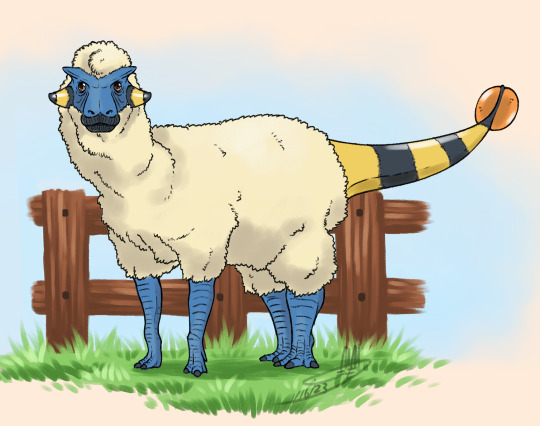
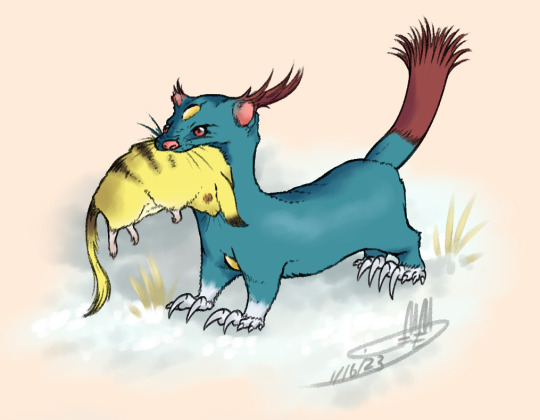
I liked a couple of those sketches, so I expanded a little on them.
#pokemon#character design#creatures#creature design#biology#realistic pokemon#paleomon#speculative biology#speculative evolution#Mareep#Sneasel#Pikachu#Nintendo#fan art#digitl art#digital illustration#Nemo's art
397 notes
·
View notes
Text
All I’m saying is that in the Pokémon universe, mitochondria are definitely Pokémon. This is why some trainers appear to have elemental types – they have unbalanced internal biospheres, leading a single type of intracellular Pokémon to dominate.
#gaming#video games#nintendo#pokémon#pokemon#worldbuilding#biology#speculative biology#body horror#(ish)#microscopic dragons all up inside you
3K notes
·
View notes
Text
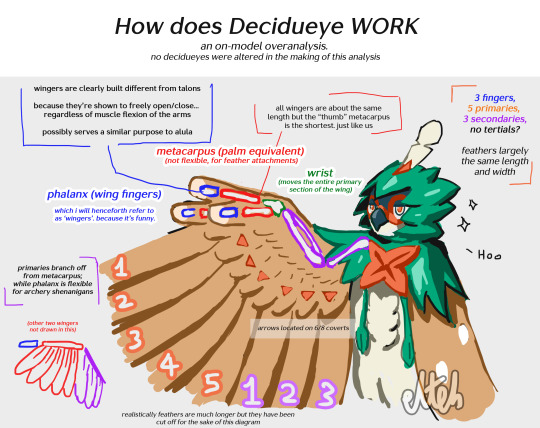
decidueye's anatomy has been bugging me so i decided to overanalyze it
disclaimer: this is in no way a 100% foolproof design
#pokemon#decidueye#rowlet#speculative biology#speculative worldbuilding#bird anatomy#wing anatomy#alola#pokemon sun and moon
259 notes
·
View notes
Text

Hoenn trio
Treecko is a small reptilian that lives high up on tree branches, it has evolved to mimic leaves for protection from predators as well as using its leaf like tails to attract Beautifly which will lay their eggs on Treeckos tail, once the eggs hatch it will keep the Wurmple on its tail for long periods of time using the Wurmple as a easy food source. the bright red stripe running down its stomach is often used as a way to scare of smaller predators.
Mudkip are Amphibious creatures living in murky waters, they have a pair brightly coloured gills though they can also breath on land, their gills are often used as a way to communicate to others of their kind using vibrations and as a way to scare of and predators.
Torchic's upper body is covered in a thick layer of feathers, this provides extra heating for the bird which it uses to help power its fire attacks, its head has a large crest which moves depending on what the Torchic is feeling, they often flare these feathers out when trying to intimidate larger Pokémon.
105 notes
·
View notes
Text
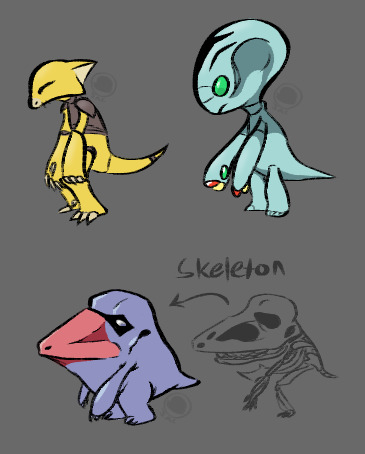
Abra, Elgyem and nosepass
Spec Bio stuff under the cut
Abra and Elgyem are more of 'cousin species' closer to armadillos than foxes. while the abra line is adapted to life in planes and grasslands, Elgyem and Beheeyem are adapted originally to mountainous regions before hitching rides on larval Solrock and Lunatone, ascending into the atmosphere and feeding on both of the megalithic skycorals.
They hollow out the titanic adult's bodies and keeping them Juuuust alive enough to stay afloat but pushed around by the family of elgyem and beheeyem with their 'psychic powers'. leading to erratic movements and stunted growth, alongside Elgyem and Beheeyem's stranger appearance leads them to be mistaken for extraterrestrials and their craft.
Nosepass and Probopass are surviving dinosaurians who retained metallized tissues in their skin over a layer of blubber to act as a futher layer of insulation.
probopass (not pictured) and Nosepass are vital predators to Magnemite and Magneton in the ecosystem, and are in turn preyed upon by Metang and Metagross.
Probopass's "mustache" is actually more a result of their body's regulation of ferrous materials. similar to how aquatic iguanas regulate excess salts in their bodies, Probopass 'Sneeze' out excess ferrous materials and dry out. whatever doesnt oxidize becomes magnetized to the probopass' snout.
Probopass' other heads are just babies that arent ready to leave the protection of their parent yet.
69 notes
·
View notes
Text
on object sleeping habits
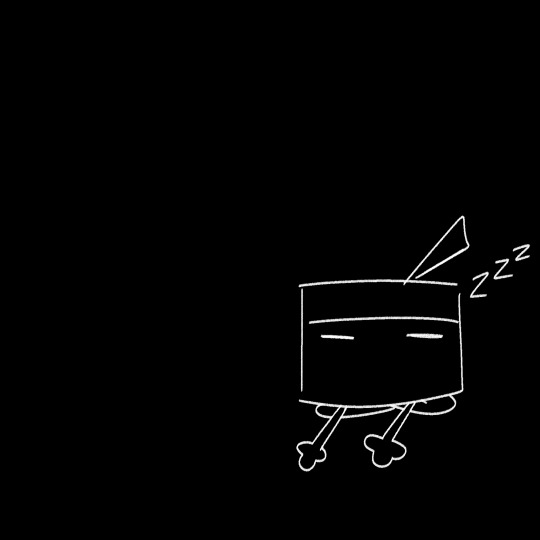

(image ID: a doodle of amelia from ONE on a black background, drawn with white outlines sleeping upright with her legs tucked underneath her and her arms laid out in front of her. the second picture shows airy next to her in the same position, legs tucked underneath him, waking her up. /end ID)
something that has been very heavily debated in the community are object sleeping habits, how they sleep, the science behind it or whether they even need to sleep at all. this post aims to go a little more in depth about it, though it won't cover everything.
for one, the anatomy and biology differs wildly between families and even individual object species. this of course affects their sleeping habits and even their circadian rhythm.
with people and animals, the way they sleep is much more obvious. humans are granted the freedom of sleeping comfortably on their backs or curled up on their sides without much issue (aside from certain health complications that may arise due to the condition(s) an individual might have.) many mammals sleep curled up, or on their sides. birds sleep with their heads tucked in their wings, or in flight if you're a swift. bats hang upside down and horses can sleep standing up on lying down. crocodiles shut off one part of their brain in order to keep a lookout or maintain flight. swifts remain in the sky for most of their lives and only ever land due to sickness or to nest, which means they fly in their sleep too. so this begs the question, how do objects sleep?
it's different for every species. due to their wild differences in anatomy as discussed earlier, they often have to learn unique adaptations that help them thrive. this extends to sleep as well. for the longest time, it was thought that objects did not need to sleep at all, though recent observations have shown otherwise. it wouldn't be feasible to cover every object's sleeping habits and patterns, so i'll be going into some more recent studies.
for one, as with the images above, objects that have flat bases or rounded bodies may find laying on their backs or sides difficult or uncomfortable. these objects sleep with their legs tucked underneath them, sitting upright or leaned against a wall or other surface. occasionally they may be found laying down if it is comfortable, but it is not often.
it also isn't uncommon to see boxes dozing off within seconds, limbs tucked beneath them, or for coins to flop onto their backs. both of these objects have body structures that compromise their abilities to rest comfortably in any other position.
objects that have a tendency to roll, like glasses or cylindrical shaped objects may rest on their backs or sides with their arms propped up by their elbows, providing a stop to keep them in place. these species tend to be very light sleepers as well, so that in the event of a threat they can awaken quickly and spring upright. this especially applies to glass objects, who exhibit unihemispheric sleep in order to remain vigilant (in other words, they sleep with only one part of their brains at a time). they are also prone to night terrors, and tend to sleep in groups that alternate between keeping watch.
#hfjone#hfjone airy#hfjone amelia#speculative biology#object shows#object sentience#unreality#object biology#yeah this is a bit of a longer one#blame pokemon sleep for making me think about this#object irl
171 notes
·
View notes
Text
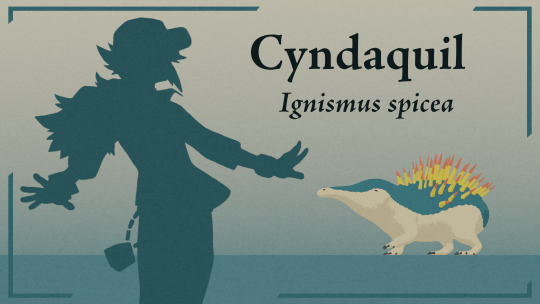
Cyndaquil - a strange animal native to Johto. They are difficult to find, despite living in grasslands and forests. These friendly-looking creatures feed primarily on insects with a long snout and even longer tongue. Due to living in borrows they have very poor eyesight.
They usually live in small groups, usually families, with parents who bond for life and newly hatched babies who stay until they are ready to live on their own. They have yellow and red spines on their backs as form of protection against larger predators such as Ninetales.
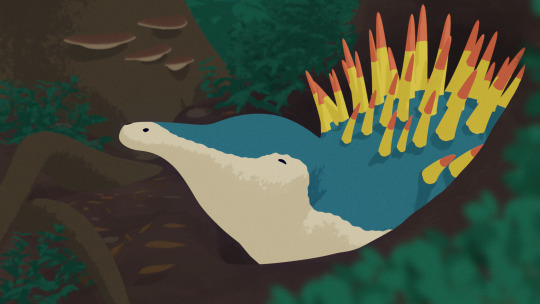
They share many similarities with their distant relatives, Quilava and Typhlosion, in both appearance and their status as one of the few egg-laying mammals.
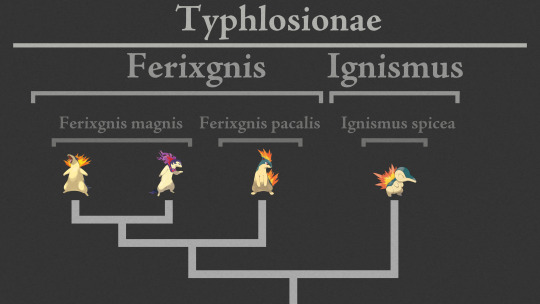
#3d#pokeart#pokemon#blender#johto#cyndaquil#typhlosion#quilava#specevo#speculative biology#speculative evolution
45 notes
·
View notes
Text
Actually shout out to Dungeon Meshi for having what I think is the most creative take on living armor. Who the hell comes up with "siphonophore-like molluscs"? That sounded like something I expect from speculative evolution and not a fantasy anime. W to the author
On a slightly unrelated note, this is almost my new headcanon on Charcadet and Armarouge/Ceruledge; they're hermit-crab like molluscs that happen to look humanoid to make it easier to fit inside discared armor, and evolving them has them weld their armor onto their skin to make a protective layer. Something about Charcadet feels octopus-like to me
#anime#dungeon meshi#delicious in dungeon#pokemon#pokemon scarlet and violet#charcadet#armarouge#ceruledge#speculative biology#Can I say that???
20 notes
·
View notes
Text


A lil speculative biology for an assignment, ft one of my favorite pokeys.
#used mostly badger anatomy for it#dw aby the scientific name its lazy lol#pokemon#typhlosion hisui#skeleton#speculative biology#mashing the bipedal and quadrupedal shoulder structure was hard#since i know typh here can walk bith ways#weirdo!#also man. is it difficult to get a good turnaround of a badger skeleton...i did a lot of guesswork#with a few mid 3d models on sketchfab ahdbshf
27 notes
·
View notes
Text
Here is a fun fact about Cradily, they love to dance! Not only that, but individual Cradily have their own music preferences. A 2005 study found a majority of Cradily show a strong preference for punk rock, however.
Cradily also have their own dance styles. Most will simply sway. Some will headbang, moving their head forward and back. Some will also wave their tentacles around in intricate patterns while swaying or headbanging. Some Cradily have even been found to "slow dance" with each other, walking back and forth on the seafloor while facing each other!
24 notes
·
View notes
Note
Pokemon request: Well you know how I feel about the Don, but I've asked for that before so... Zoroark? Either regular or Hisuian.
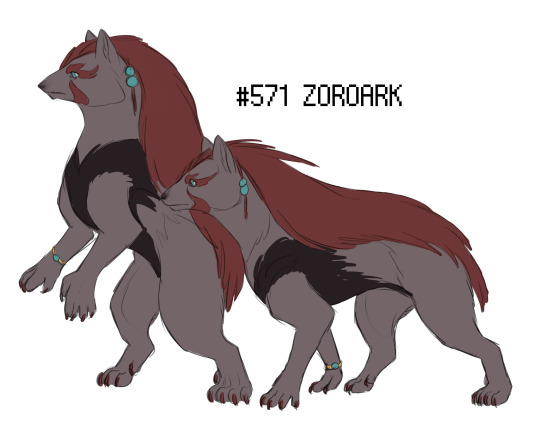
One of the handful of pokémon species that are fully sapient. For the most part, zoroark colonies isolate themselves from humans. Certain individuals may choose to live among humans, partner with a human, or become a trainer themselves, though this is rare.
Contrary to popular belief, they are not mute, but their mouths simply cannot form human words. Under the guise of magical illusion the species is known for, however, they can be capable speakers.
[send me a pokémon and i'll draw it semi-realistically and add my headcanons]
#realistic pokemon#zoroark#pokemon#pokemon bw#pokemon bw2#speculative biology plus weird magic stuff plus worldbuilding is honestly why i love pokemon so much#like. this is the kind of world where sometimes your neighbor is just a magic fox casting an illusion#wild#anyway i'd have to dig into hisuian zoroark lore more before i made one for them#but unovan zoroark is one of those mons i have lots of thoughts about#autumn.art#autumn.fandom
43 notes
·
View notes
Text
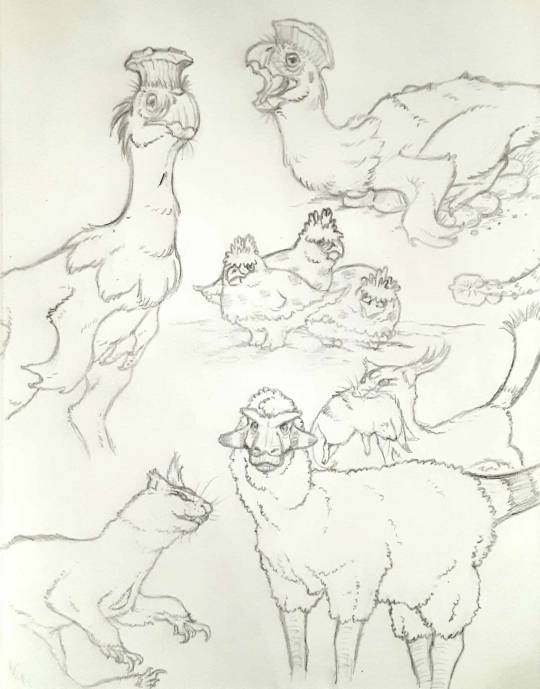
My realistic Pokemon art has returned from the war.
In descending order: Breloom and Shroomish inspired by theropod dinosaurs. Mareep as a mix of a sheep and a hadrosaur dinosaur, I like the idea of the Mareep line being sheep-shaped dragons rather than just sheep (because Ampharos). And finally Sneasel, obviously a mustelid specifically a stoat as reference. And a very dead Pikachu somewhere in the mix.
#pokemon#character design#creatures#creature design#biology#realistic pokemon#paleomon#speculative biology#speculative evolution#dinosaurs#mammals#breloom#Shroomish#Mareep#Sneasel#Pikachu#Nintendo#fanart#sketches#traditional art#Nemo's art
21 notes
·
View notes
Note
I absolutely love your concept of chansey as a bird-like pokemon. It's such a unique idea and it works so well. Now I'm picturing audino as something similar but smaller. Perhaps the two had a common ancestor? IDK, it's just fun to think too deep about this stuff.
So sorry it took forever to get back to you! Life was very busy and then by the time I had crafted a response, my scanner died ;a;
But I'm glad you like my art, and I love the idea of Chansey and Audino sharing a common ancestor! Here's my attempt at some weird little dudes.


I think Audino's "feelers" evolving from whiskers is kind of fun idk
#asks#fruitbird15#art#traditional art#pokemon#fanart#speculative biology#pocket monsters#audino#chansey#WEIRD GIANT ANCESTOR#audino has less of a beak than chansey#and their ancestor had one of those kinda razor beaks?#monster design#creature design#redesign#?#pokemon redesign
17 notes
·
View notes
Text
I've been working on this Color Wheel challenge on Twitter and Instagram for the last few weeks and I think it's time to bring it here :>
I just finished the cyan section, which means you can suggest blue creatures or characters from any media you want and I'll draw it (or any of the remaining colors if you want uvu)
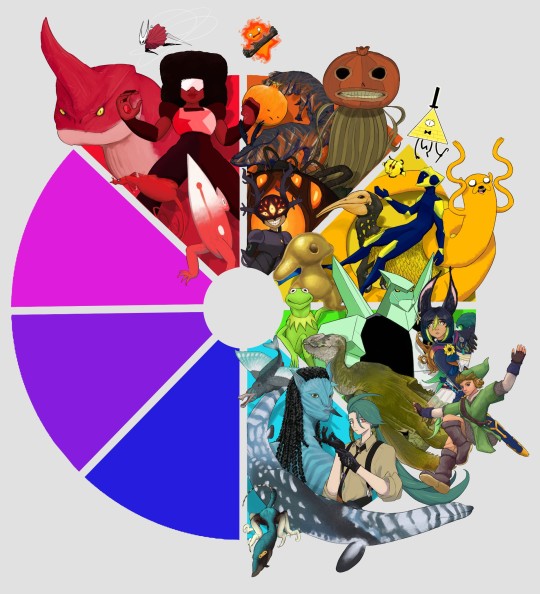
Here's a close-up of the section, featuring a Flish from The Future is Wild, Rika from Pokémon, a Na'vi from Avatar, Giant Severateel from Sinedey and Furcagnathodon from the Kiatra project!!
🩵🐬🩵
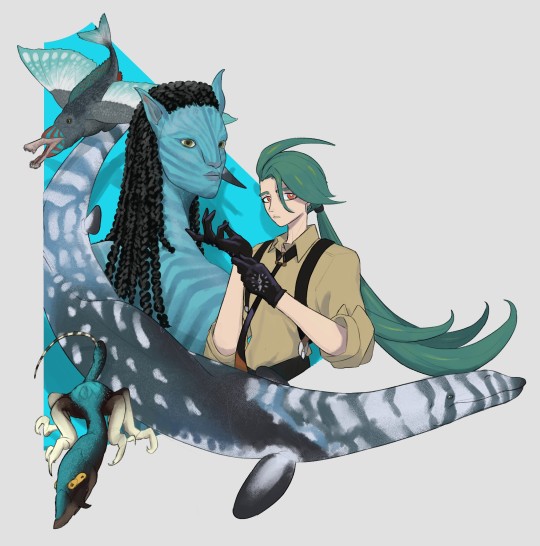
#art#illustration#speculative biology#speculative evolution#pokemon#avatar#the future is wild#xenobiology#fanart
20 notes
·
View notes